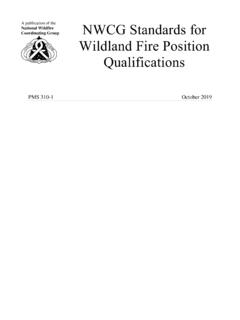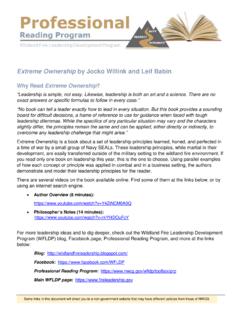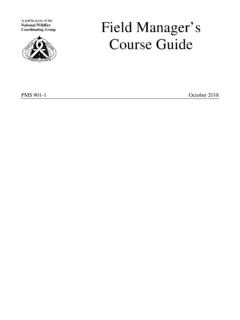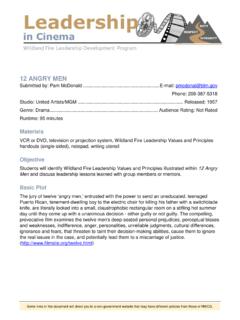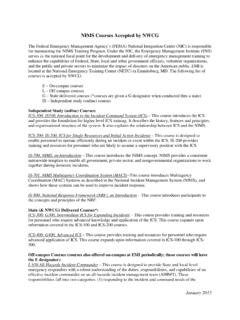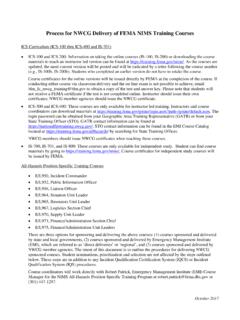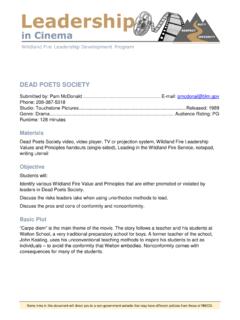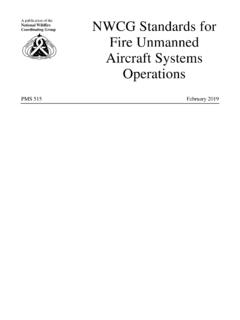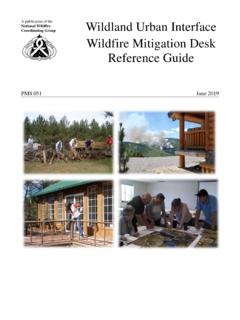Transcription of A publication of the National Wildfire Incident Response ...
1 A publication of the National Wildfire Incident Response Coordinating Group Pocket Guide PMS 461 April 2018. NFES 001077. SIZEUP REPORT. Incident Type (wildland fire, vehicle accident, hazmat spill, search and rescue, etc.). Location/Jurisdiction Incident Size Incident Status Establish IC and Fire Name Weather Conditions Radio Frequencies Best Access Routes Assets/Values at Risk Special Hazards or Concerns Additional Resource Needs This reference is intended to assist in reporting key information regarding Incident conditions when first arriving on scene.
2 All agencies will have specific information requirements that may involve additional reports. Incident Response Pocket Guide April 2018. PMS 461. NFES 001077. The Incident Response Pocket Guide (IRPG) establishes standards for wildland fire Incident Response . The guide provides critical information on operational engagement, risk management, all hazard Response , and aviation management. It provides a collection of best practices that have evolved over time within the wildland fire service. The IRPG does not provide absolute solutions to the unlimited number of situations that will occur.
3 Some fireline decisions may be relatively simple; many are not. These decisions often require individual judgment and creativity . skills developed through extensive training, dedicated practice, and experience The National Wildfire Coordinating Group (NWCG) provides National leadership to enable interoperable wildland fire operations among federal, state, tribal, territorial, and local partners. NWCG. operations standards are interagency by design; they are developed with the intent of universal adoption by the member agencies. However, the decision to adopt and utilize them is made independently by the individual member agencies and communicated through their respective directives systems.
4 2018 Revision Summary This edition reflects feedback and input received since the 2014 version. Therefore, the cover color has been changed to purple. The notable changes include: New References Smoke Hazards and Mitigations Smoke and Transportation Safety Principles of Airtanker and Water Scooper Use Recommended Retardant Coverage Levels Important Winds to Firefighters Alignments and Patterns for Dangerous Fire Behavior Helicopter Extraction Operations Deleted References Flight Following Working with Airtankers Severe Fire Behavior Potential Related to RH and Fuel Moisture Content Existing References with Significant Changes Added Assets/Values at Risk to Size Up Report Added LCES to Briefing Checklist Revised
5 Look Up, Down, and Around Added Critical Burn Period to Common Denominators of Fire Behavior on Tragedy Fires Emphasized effects of slope and wind on Safety Zones Updated Wildland Urban Interface Firefighting Removed the 30/30 Rule in Thunderstorm Safety Edited Last Resort Survival Updated Aviation User Checklist Revised Retardant Use Reminders Updated Directing Retardant and Bucket Drops Updated Spot Weather Forecast information Updated Medical section including the Medical Incident Report IRPG i Table of Contents 2018 Revision Summary.
6 I Operational vi Communication x Leader's x Human Factor Barriers to Situation Awareness .. xi After Action Review (AAR) .. xiii OPERATIONAL ENGAGEMENT green pages .. 1. Risk 1. Planning for Medical 2. Look Up, Down and Around .. 3. Common Denominators of Fire Behavior on Tragedy Fires .. 5. Common Tactical Hazards .. 6. 7. Safety 8. Downhill 9. Indicators of Incident Complexity .. 10. Wildland Urban Interface Firefighting .. 12. SPECIFIC HAZARDS gray pages .. 19. How to Properly Refuse Risk .. 19. Thunderstorm Safety .. 21. Hazard Tree Safety.
7 22. Powerline Safety .. 24. Roadside Response 26. Unexploded Ordnance Safety .. 27. Oil and Gas Site Safety .. 28. Smoke Hazards and Mitigation .. 30. Smoke and Transportation 31. IRPG ii Last Resort Survival .. 32. ALL HAZARD Response yellow pages .. 35. Vehicle Accident 35. HazMat Incident 36. HazMat Isolation 37. HazMat Classification for Fixed Facilities .. 38. Local Disaster Response .. 39. All Hazard Incident Response .. 40. Structure Hazard Marking System .. 41. Missing Person Search Urgency .. 42. AVIATION blue pages .. 45. Aviation User Checklist.
8 45. Aviation Watch Out 46. Helicopter Passenger Briefing and 47. Helicopter Landing Area Selection .. 50. One-Way Helispot .. 51. Two-Way Helispot .. 52. Longline Mission .. 53. Helicopter Hand 54. Paracargo Operations Safety .. 55. Weight Estimates .. 56. Aerial Retardant Safety .. 57. Directing Retardant and Bucket Drops .. 58. Principles for Airtanker and Water Scooper Use .. 59. Retardant and Suppressant Use Reminders .. 60. Recommended Retardant Coverage Levels .. 61. Aircraft Mishap Response Actions .. 62. SAFECOM Reporting System.
9 63. OTHER REFERENCES white pages .. 65. Spot Weather Forecast .. 65. IRPG iii Weather Watch/Weather 67. Energy Release Component (ERC) .. 67. Burning Index (BI) .. 67. Haines Index (HI) .. 68. Keetch-Byram Drought Index (KBDI) .. 68. Lightning Activity Level (LAL) .. 69. Important Winds to Firefighters .. 70. Beaufort Scale .. 72. Alignments and Patterns for Dangerous Fire Behavior .. 73. Fire Behavior Hauling Chart .. 75. Relative Humidity: 1,400-4,999' Elevation .. 76. Relative Humidity: 5,000-9,200' Elevation .. 77. Probability of Ignition 78.
10 Strategy Direct Attack .. 82. Strategy Indirect Attack .. 83. Fireline Location .. 84. Procedural Felling Operations .. 85. Working with Heavy Equipment .. 86. Water Delivery Information .. 87. Engine ICS 88. Water Tender ICS Typing .. 88. High Pressure Pump Information .. 89. Troubleshooting a High Pressure Pump .. 91. Average Perimeter in Chains .. 94. Fire Size 94. Line Spike .. 95. Minimum Impact Suppression Tactics .. 97. Reporting Fire Chemical Introductions .. 99. Fire Origin Protection Checklist .. 100. Media Interviews .. 101. IRPG iv Phonetic Alphabet.
